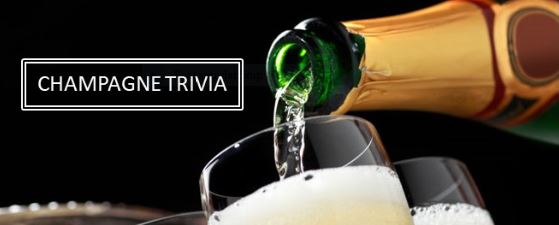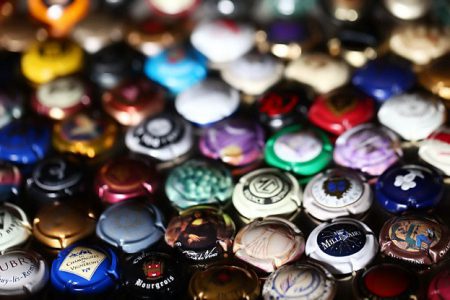
Champagne conjures up images of celebration, fun, happiness … but beware, it can also be a dangerous thing.
DANGER ZONE
There is a lot, and I mean a lot of pressure in a bottle of Champagne … typically between 70-90 pounds per square inch. For comparison, that’s about 2-3 times the pressure in a car tyre … so a lot.
 Which means when the cork leaves the bottle, it does so with a huge amount of force behind it, and can be quite lethal. You are more likely to be killed by a flying Champagne cork than by a poisonous spider and on average about 2 doz. people are killed annually by Champagne corks, with the majority of these accidents happening at weddings.
Which means when the cork leaves the bottle, it does so with a huge amount of force behind it, and can be quite lethal. You are more likely to be killed by a flying Champagne cork than by a poisonous spider and on average about 2 doz. people are killed annually by Champagne corks, with the majority of these accidents happening at weddings.
And with so much force behind it, a flying Champagne cork can reach a speed of up to 64 km p/hr and can travel quite a distance, with the longest cork flight ever recorded being more than 177 feet (54 metres).
——-
SAVE YOUR CAPS

Champagne corks are held in place atop the bottle with a wire cage called a ‘muselet’ and the metal cap bearing the Champagne house’s name, logo or cuvée is the ‘plaque de muselet’. Since the majority of Champagne houses personalize these plaques, they have become sought after collector’s items and if you’re a serious collector of these you’re called a placomusophile. There are a variety of options available for storage and display of Champagne plaques from special albums, to glass-fronted display cases and wooden display boards.


Special event plaques can be inscribed or engraved with the date or special event, and if you have a really special cap that you like to keep close by at all times, you can order a piece of jewellery from Wearing Memories Australia to wear your cap in. They have a variety of items in their Couture Range made from Australian sterling silver, and also in the more affordable Ready 2 Wear Range, made from bronze.

Some collector’s get pretty obsessed with their collections, cataloguing, inscribing, filing and displaying, and even creating art or furniture from their caps. If you’ve collected like a gazillion champagne caps, you can put them to use in some fun diy projects, like a champagne cap table top covered in resin, or a backsplash for your wetbar made from caps, and if you’re feeling particularly artistic, a modern art mosaic piece.
——-
THE NAME’S BOND
Probably one of the most well-known Champagne drinking screen stars is 007, drinking Champagne in the Bond movies in excess of 40 times, more than any other drink, even more times than his famous Shaken Not Stirred Martini. Although in the movies, the favoured Champagnes are Bollinger and Dom Perignon, author Ian Fleming’s favourite was Taittinger being mentioned in the books Casino Royale, Moonraker, On Her Majesty’s Secret Service and Goldfinger. However, Taittinger’s last screen appearance was in From Russia with Love in 1963.
 ——-
——-
BACK IN HISTORY
In 19th century England men used to polish their boots with Champagne …. Yes .. Polish .. With Champagne!
In the 1800’s high society dandies who strove to imitate aristocratic lifestyles despite coming from middle-class backgrounds, thought the best way to polish their boots was with Champagne. Have you ever?

——-
WHAT’S YOUR POISON
The necks of Champagne bottles are wrapped in foil. Besides the aesthetics, this is mainly to protect the cork from being eaten by rodents and to protect it from cork weevil. Previously the foil was made from lead, but lead is toxic and research showed that trace amounts of it could remain on the lip of the bottle and mix with the poured Champagne. Lead neck foils have been phased out and since the early 1990’s most neck foils are made from tin, heat shrink plastic or aluminium.

——-
GREEN, GREEN BOTTLES
Ever wondered why the majority of Champagne bottles are green? It’s all to do with UV exposure … and a little bit of cost as well.

Wine, and especially a wine as sensitive as Champagne, does not like UV light and extended exposure to UV light affects the stability of wine, caused by sulphurous compounds forming due to chemical reactions, it will show changes in colour, aroma and taste and the wine is then declared as ‘light-struck’.
Although green glass blocks UV light by between 30-50%, it is not the best colour to offer protection. That would be amber glass, which offers UV protection of almost 90%, however, green glass still remains the easiest and cheapest to produce in large quantities. FYI clear glass is only able to block about 10% of UV rays.
So why are there some Champagnes in clear bottles you ask? Let’s look at the story of Louis Roederer’s Cristal. Presented in a clear bottle with a flat bottom, Cristal was originally produced like this at the request of Tsar Alexander II of Russia in the late 1800’s who feared assassination attempts and therefore asked for a clear bottle so he could detect any poison, also requesting a flat bottom to prevent something lethal from being hidden inside the punt.

To this day Cristal is produced like this and since the early 1980’s each bottle of Cristal comes wrapped in gold anti-UV cellophane and it’s a good idea to keep your precious bottle wrapped until you are ready to drink it.

——-
CHAMPAGNE AND A SHIPWRECK
The official Champagne on board the ill-fated Titanic was Heidsieck & Co. Monopole Blue Top. And since Champagne bottles are made from much thicker glass than wine, these bottles could withstand the pressure of the ocean’s depths and intact bottles were found during salvage expeditions.

The water pressure worked perfectly to help the corks stay in place and keep the effervescence inside the bottles. Lying beneath the waves in complete darkness at constant temperatures for years actually makes for pretty perfect cellaring conditions.
 In 2012, a 10-course dinner was hosted at a luxury Hong Kong hotel with a recovered vintage from the Titanic, a 1907 Heidsieck & Co Monopole. The dinner was based on a menu from the Titanic’s First Class dining room and would have set you back $15,000 per person.
In 2012, a 10-course dinner was hosted at a luxury Hong Kong hotel with a recovered vintage from the Titanic, a 1907 Heidsieck & Co Monopole. The dinner was based on a menu from the Titanic’s First Class dining room and would have set you back $15,000 per person.
——-
More Facts, Myths, Trivia .. in Part 1.
Pop, Fizz, Clink
The Champagne Chick
xo
Reblogged this on BubblyBEE.net and commented:
Fabulous gift idea to commemorate a special occasion…champagne cap jewelry…Wearing Memories Australia. Thank you for sharing the bubbly fun Champagne Chick!
LikeLike